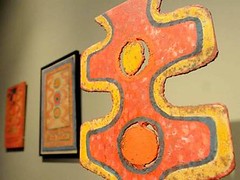Cameron exhibit sings praises of Connell's love of nature
By Justin Lacy
StarNews Correspondent
Published: Tuesday, August 2, 2011 at 8:39 a.m.
Paul Stephen photo
A new exhibit, 'Clyde Connell: Swamp Songs' features a wide range of work from the celebrated Louisiana artist at the Cameron Art Museum.
Louisiana's Lake Bistineau sings with the prattle of wildlife.
"It's amazing," said Clyde C. Ent, daughter of the late artist Clyde Connell, whose totemic sculptures and paintings are on exhibit at Wilmington's Cameron Art Museum. "You go out and sit on the pier, and you hear birds. Herons squawking. Insects. Fish jumping in the water around the cypress. And you would hear frogs. Sometimes, especially in the evening, it gets really loud."
"Clyde Connell: Swamp Songs," is more than a memorial for Connell, who passed away in 1998 at the age of 96. It's a musical score to the soundscape of the Louisiana wetlands, and Connell's rune-like drawings, wall reliefs, woodprints and sculptures are a visual representation of the natural rhythm and hum of the bayou, and of the wails and moans of its people.
Connell was born in Belcher, La., in 1901. She grew up on a large cotton plantation, an experience that influenced her involvement with the Civil Rights Movement and left her with a lasting sympathy for Southern blacks and an affinity for their art and culture.
"She felt that people just had to learn to live together," Ent said.
On constant loop in the CAM exhibition is a film documenting Connell and her work made by Adam Simon in 1985 in completion of his honors thesis at Harvard. At the heart of the film is Connell's description of an elderly African-American nurse, grieving at the news of a nearby lynching.
"She said that this old woman was close to the man who was killed," Simon wrote to the CAM, "and she recalled how on one of their frequent walks through the woods the old woman had wept and wailed and moaned about the violent events. Clyde said these sounds were the sounds she still heard to this day. And I felt this was the ‘twist' in the tale as it were – that the swamp song was not just (or not so much) simply the sounds of the woods and bayous – but the anguished human sounds she heard from this woman, which somehow stood for Clyde as the entire unspoken dark history that lay beneath her feet."
Toward the front of the exhibition are Connell's early representational works, including low-relief woodprints of black prisoners on the penal farm where her husband, T.D. Connell, was a superintendent. Connell carved these by hand, using a hammer and a screwdriver.
As the exhibition progresses, Connell's sculptures are introduced – primordial pieces that act more as meditative places than detached structures.
Connell didn't begin producing her three-dimensional works until after 1959. That's when she and her husband moved into a house on the remote edge of Lake Bistineau. Prior to the move, Connell had visited the New York galleries and became fixated on the Abstract Expressionism movement. She gave up on figural works to focus on sculpture.
Connell worked with readily available materials – rusted nails, bolts, springs, iron, glue, paper pulp, paper sacking, newsprint, cypress, cedar and rattan – to create her sculptures in several series. There are "Guardians" evocative of one-eyed shaman swallowed by the swamp. "Posts," standing like cypress knees with long black horsehair growing from their tips. There's "Dialogue Gate," a tall, four-legged tower sculpture on loan from the National Museum of Women in the Arts in Washington, D.C. Rusted nails stain its leathery skin, a papier-mâché coating that, before it hardened, Connell and her family referred to as "gunk." Gunk was always in supply.
"If you opened the fridge you might see a carton of orange juice," Ent said, "but the rest was full of gunk. The doorknobs and everything in the house was covered in gunk."
Connell's sculptures were composed of and entirely related to their swamp surrounding. And that's where she intended to keep them, no matter if they were susceptible to the Louisiana elements.
"That's one of the things that gives me chills every time," said Holly Tripman, registrar of the Cameron Art Museum. "She kept a lot of sculpture outside. They'd say, ‘You need to bring them in,' and she'd say, ‘No, document them but let them go, everything has its time."
Simon's film reveals many of the sculptures on display at CAM in their natural habitat along the lake. He begins with dream-like shots of the Spanish-moss-laden Bistineau, slowly introducing Connell's sculptures to the scenery.
It was the soundscape around her that brought about her most iconic works: the actual "Swamp Songs," strange and delicate sheets of graphical charcoal notation, written in rows like ancient hieroglyphics. Every morning, Connell rose early and sat on her pier to transcribe the music of the swamp – the sounds of nature, and the cries of man.
"A couple of weeks ago," Ent said, "we were watching a PBS special on Dave Brubeck, and one thing he said really brought tears to my eyes. He said, ‘When I open the door, I hear my music.' And I thought, that's exactly what my mother did. When she sat in that chair on her pier, she would hear and feel her art."
Features: 343-2343
Tuesday, August 9, 2011
Subscribe to:
Posts (Atom)


